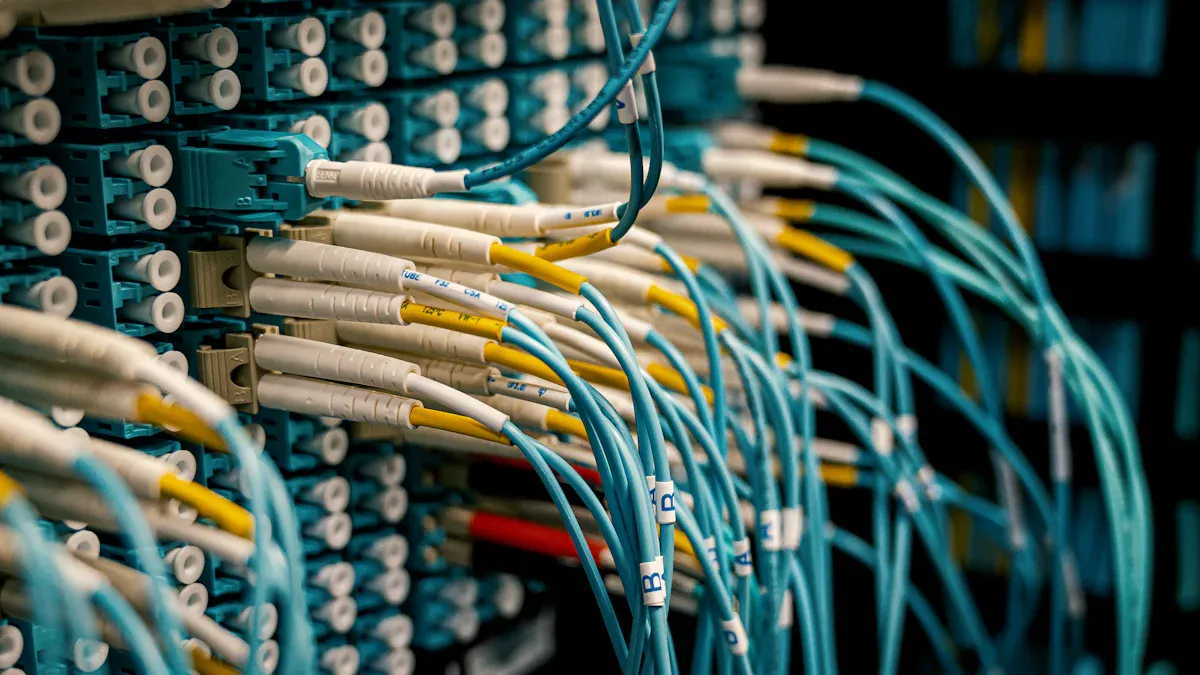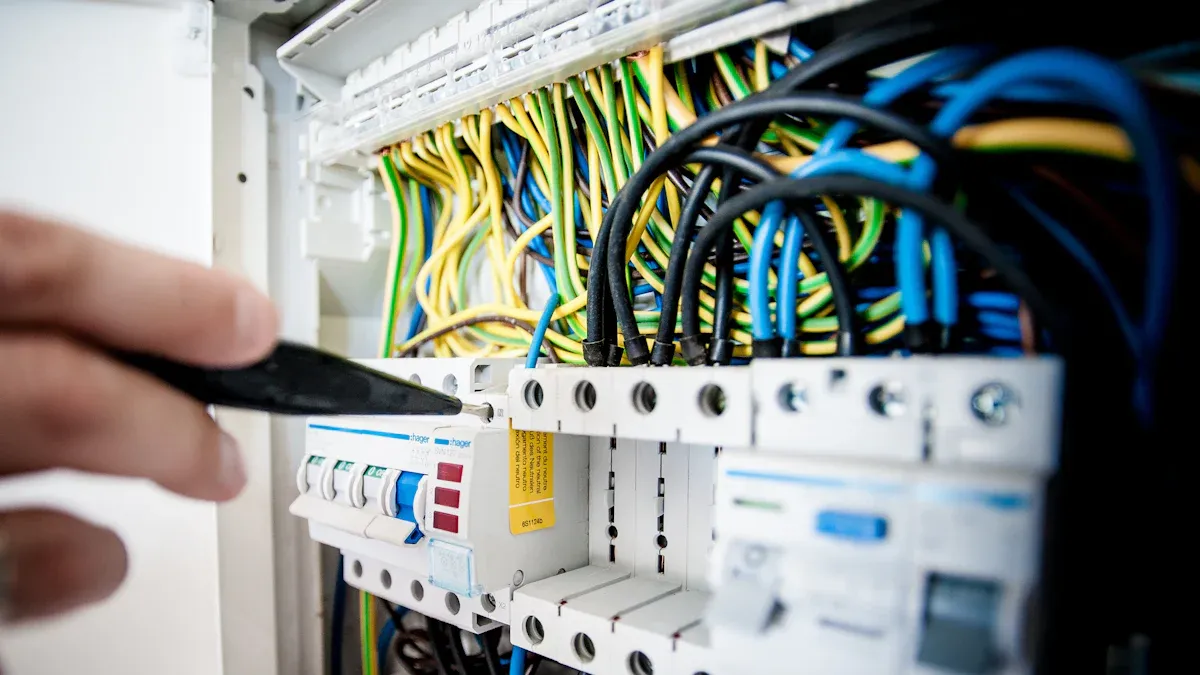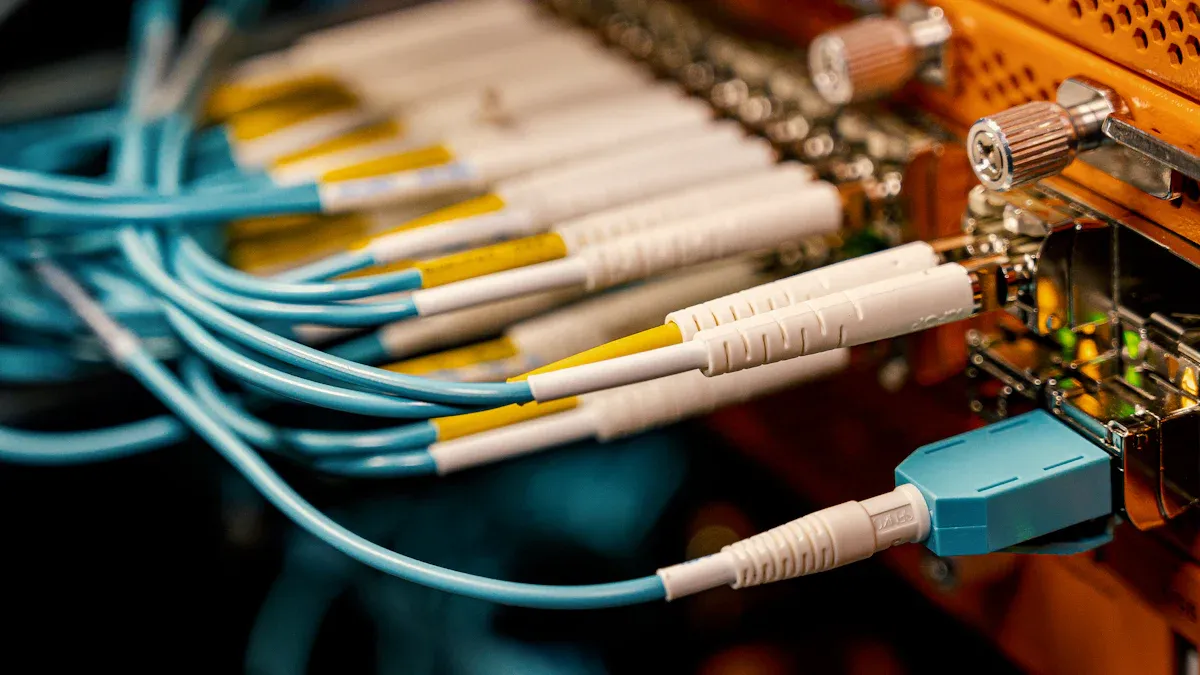
When you need a dependable solution for indoor data transmission, an indoor simplex armored optical fiber cable stands out. Its robust design ensures durability even in challenging environments. Unlike traditional cables, its armored layer protects against physical damage, making it ideal for high-traffic areas. You can rely on its advanced construction to maintain signal clarity and reduce data loss over long periods. Furthermore, the materials used in this fiber optic cable meet strict safety standards, ensuring a secure and efficient setup in your space.
Key Takeaways
- Indoor fiber cables send data reliably with little signal loss.
- A strong outer layer keeps them safe from damage and lasting longer.
- These cables are light and bend easily, making setup simple.
- They are made with fire-safe materials to lower smoke in fires.
- Checking them often and installing them right helps them work well.
Design Features of Optical Fiber Cable

Construction and Materials
The construction of an optical fiber cable plays a vital role in its reliability. These cables use high-quality materials like glass or plastic for the core, which transmits light signals. The cladding, a protective layer around the core, ensures the light stays within the cable. This design minimizes signal loss and enhances performance. Surrounding the cladding, a buffer coating adds another layer of protection against moisture and physical damage.
You’ll also find that the outer jacket of the cable is made from durable materials like PVC or LSZH (Low Smoke Zero Halogen). These materials resist wear and tear, making the cable suitable for indoor environments. Each component works together to create a cable that delivers consistent performance and withstands daily challenges.
Armored Layer for Enhanced Protection
An armored layer sets these cables apart from standard ones. This layer, often made of steel or aluminum, shields the cable from physical damage. It prevents crushing, bending, or accidental cuts, especially in high-traffic areas.
If you’re installing cables in places where they might face mechanical stress, this feature becomes essential. The armored layer ensures the optical fiber cable remains intact, even under challenging conditions. This added protection extends the cable’s lifespan and reduces the need for frequent replacements.
Lightweight and Flexible Design
Despite their robust construction, these cables remain lightweight and flexible. You can easily install them in tight spaces or around corners without compromising their performance. Their flexibility simplifies the installation process, saving you time and effort.
The lightweight design also reduces strain on support structures, making it ideal for indoor use. Whether you’re setting up a data center or wiring an office, this feature ensures the cable adapts to your needs without adding unnecessary bulk.
Performance Benefits of Optical Fiber Cable
Resistance to Physical and Environmental Damage
Indoor optical fiber cables excel in durability. Their design protects them from physical harm, such as crushing or bending. The armored layer acts as a shield, ensuring the cable remains intact even in high-traffic areas. You can trust these cables to resist environmental factors like moisture and temperature fluctuations.
Tip: When installing cables in areas prone to mechanical stress, choose armored optical fiber cables for added protection.
This resilience makes them ideal for indoor environments where cables face constant wear and tear. Whether in a busy office or a residential space, these cables maintain their integrity under challenging conditions.
Signal Integrity and Low Attenuation
Signal quality is a critical factor in data transmission. Optical fiber cables are designed to minimize signal loss, ensuring consistent performance. The core and cladding work together to keep light signals confined within the cable, reducing attenuation.
You’ll notice that these cables deliver high-speed data transmission with minimal interference. Unlike traditional copper cables, they resist electromagnetic interference, maintaining signal clarity. This feature is especially important in environments with multiple electronic devices.
- Benefits of Signal Integrity:
- Reliable data transmission over long distances.
- Reduced risk of data loss or corruption.
- Enhanced performance in high-demand applications.
Longevity and Minimal Maintenance
Optical fiber cables offer long-term reliability. Their robust construction reduces the need for frequent replacements. You won’t have to worry about constant maintenance, as these cables are built to withstand daily challenges.
The materials used in these cables resist wear and tear, ensuring they last for years. This longevity saves you time and money, making them a cost-effective choice for indoor setups.
Note: Regular inspections can help identify potential issues early, further extending the cable’s lifespan.
By choosing optical fiber cables, you invest in a solution that delivers consistent performance with minimal upkeep.
Safety Standards and Compliance
Fire-Resistant and Low-Smoke Materials
When choosing an optical fiber cable for indoor use, safety should be your top priority. These cables often use fire-resistant materials that reduce the risk of fire spreading. In case of a fire, the materials emit minimal smoke, which helps protect people and equipment.
Tip: Look for cables labeled as LSZH (Low Smoke Zero Halogen). These cables are designed to release less toxic gas and smoke during combustion, making them safer for indoor environments.
This feature is especially important in spaces like offices, schools, and residential buildings where safety regulations are strict. By selecting cables with fire-resistant properties, you create a safer environment for everyone.
Adherence to Indoor Cabling Regulations
Indoor optical fiber cables comply with strict cabling regulations to ensure safety and reliability. These regulations cover aspects like fire resistance, material quality, and installation standards. You can trust that these cables meet the necessary requirements for indoor use.
For example, many cables are tested to meet flame-retardant standards, ensuring they perform well in emergencies. By using compliant cables, you avoid potential legal issues and ensure your setup aligns with industry standards.
Note: Always check the product specifications to confirm compliance with local and international cabling regulations.
Certifications for Safety and Reliability
Certifications provide assurance that the optical fiber cable you choose meets high safety and performance standards. Look for certifications like UL (Underwriters Laboratories) or CE (Conformité Européenne). These certifications indicate that the cable has undergone rigorous testing.
Certified cables not only enhance safety but also ensure long-term reliability. You can confidently use them in critical environments like data centers or educational institutions.
By choosing certified cables, you invest in a product that delivers both safety and performance. This decision protects your equipment and ensures uninterrupted data transmission.
Applications of Indoor Optical Fiber Cable

Data Centers and Server Rooms
Data centers and server rooms demand high-speed, reliable data transmission. Indoor optical fiber cables excel in these environments. Their ability to handle large volumes of data with minimal signal loss ensures smooth operations. You can trust these cables to maintain signal integrity even in high-demand setups.
Their lightweight and flexible design simplifies installation in tight spaces, such as server racks. The armored layer protects the cables from accidental damage during maintenance or upgrades. Additionally, their resistance to electromagnetic interference ensures uninterrupted performance, even in areas with multiple electronic devices.
By choosing optical fiber cables for your data center, you enhance efficiency and reduce downtime. These cables provide the reliability needed to support critical operations.
Office and Commercial Spaces
In offices and commercial buildings, seamless connectivity is essential. Indoor optical fiber cables deliver fast and stable internet connections, supporting activities like video conferencing, cloud computing, and file sharing. You’ll notice improved productivity when your network runs without interruptions.
These cables are also ideal for structured cabling systems. Their flexibility allows easy routing through walls, ceilings, or conduits. The fire-resistant materials used in their construction add an extra layer of safety, making them suitable for crowded spaces.
Whether you’re setting up a small office or a large commercial complex, optical fiber cables ensure your network meets modern demands.
Residential and Educational Environments
Homes and schools benefit greatly from the reliability of indoor optical fiber cables. In residential settings, these cables support high-speed internet for streaming, gaming, and smart home devices. You can enjoy a lag-free experience, even with multiple devices connected.
In schools, reliable connectivity is crucial for online learning and digital classrooms. Optical fiber cables provide the bandwidth needed to support multiple users simultaneously. Their durability ensures long-term performance, reducing the need for frequent replacements.
By installing these cables, you create a future-ready environment that supports both learning and leisure.
Indoor simplex armored optical fiber cables offer a dependable solution for your indoor connectivity needs. Their durable design protects against physical damage, ensuring long-lasting performance. You can rely on these cables to maintain signal quality, even in demanding environments. They also meet strict safety standards, making them a secure choice for homes, offices, and data centers. By choosing an optical fiber cable, you invest in a reliable and efficient setup that supports your connectivity requirements for years to come.
FAQ
1. What makes indoor optical fiber cables better than copper cables?
Optical fiber cables transmit data faster and with less interference than copper cables. They resist electromagnetic interference and offer higher bandwidth. You’ll also find them more durable and lightweight, making them ideal for modern indoor setups.
Tip: Choose optical fiber cables for high-speed, reliable data transmission in demanding environments.
2. Can I install indoor optical fiber cables myself?
Yes, you can install them if you follow proper guidelines. Their lightweight and flexible design simplifies installation. However, hiring a professional ensures optimal performance and compliance with safety standards.
Note: Incorrect installation may lead to signal loss or damage to the cable.
3. Are indoor optical fiber cables safe for residential use?
Absolutely! These cables use fire-resistant and low-smoke materials, making them safe for homes. They meet strict safety standards and reduce risks during emergencies.
- Key Features for Safety:
- Fire-resistant materials
- Low smoke emission
- Compliance with indoor cabling regulations
4. How long do indoor optical fiber cables last?
Indoor optical fiber cables can last over 25 years with proper care. Their robust construction and resistance to wear and tear ensure longevity. Regular inspections help identify potential issues early, further extending their lifespan.
Emoji Reminder:
Post time: Jun-05-2025
